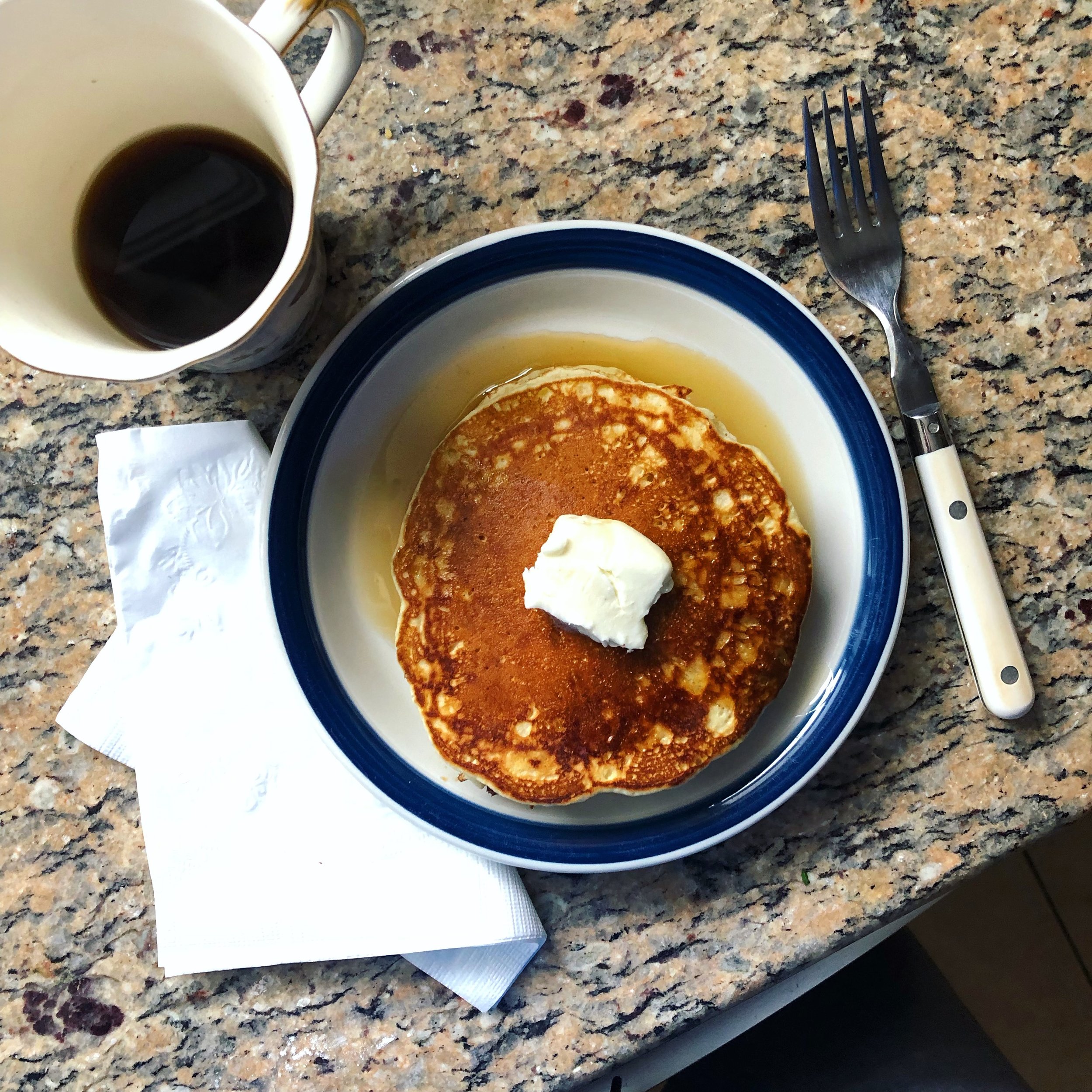It was the Summer of 2017. I had my senior year of college to look forward to, but I needed to pay the bills in the meantime. So… I cut grass. A lot of it, every day, all day. Greens, tees, fairways, roughs… yup, I worked at a golf course, and for whatever reason, I very closely associate this time of my life with pancakes. I don’t what it was about cuttin’ grass, but every morning I wanted pancakes… When I wasn’t eating them, I was thinking about them, and I had a lot of time think out there on the links. Thus was the origin for my personal quest to create the perfect pancake.
What makes a perfect pancake? Well… for me, I want a tender, light, and fluffy pillow of lightly sweet cake that gently breaks away at the very sight of a fork. It as to be golden brown, but not crisp. And it must be served with a large pad of salted butter and warm, real maple syrup. In theory, this should be easy to achieve, as pancakes only require a few ingredients to make. However, we are entering the realm of baking, so precise measurements really do make a world of difference. Luckily for you, I basically spent my whole summer tweaking the measurements for each ingredient, eventually arriving at what I am calling the definitive pancake recipe.
A few things to note… First, do not use bread flour! Gluten might be our friend when making sourdough, but we don’t want any “chew factor” in these pancakes. We want to use cake flour because it contains just enough gluten for our pancakes to hold a shape, but not enough to cause undesired chewiness. Also, most brands of cake flour contain cornstarch, which contains no gluten whatsoever. These cornstarch particles will disperse themselves throughout the batter, ultimately blocking gluten strands from interacting with each other and ensuring we have a tender pancake. Also, we have one more helper in the fight to prevent gluten formation: fat. It might not be obvious to our eyes, but the melted butter will essentially lubricate our batter, making it very hard for the gluten molecules to latch onto each other and create a matrix. This a good thing, and it will lead to a softer crumb. EDIT Jan 7, 2020: I have since replaced the butter with the same amount of neutral oil. Since it is fluid at all temperatures and there are no milk solids, I believe it leads to a more tender and moist pancake. Yes you will lose butter flavor, but you will get that back once you slather your cooked pancakes with melted butter (definitely do this).
There is also a very fine chemistry going on here, particularly involving acids and bases. Acidity is provided by the buttermilk, and… er… basicity is provided by the baking powder and baking soda. The maillard reaction, as you might have read in my other posts, is the reaction that takes place when food darkens in color in the presence of heat. This reaction, actually occurs more readily in a basic environment, so… adding more baking soda / baking powder will cause your pancakes to darken quicker. This is a delicate balance for a few reasons… One is that basicity is not pleasant to the human palate. Drop a pinch of baking soda on your tongue and you will find that it taste soapy and all around disgusting. On the flip side, we don’t want a pale pancake, so we add just a pinch to help promote browning. Also, both baking powder and baking soda contribute to the leavening of our pancake (very important). I won’t dive too deep into the science, but baking powder activates when the batter hits the stove, generating gas bubbles that will lift your pancake into an airy pillow of yum. Baking soda contributes mostly to color, however, it does react with acid to develop some initial bubbling. Regardless, this recipe has the acids and bases balanced for you already. If you must substitute the acidic buttermilk for regular milk, I encourage you to squeeze a lemon into the batter or perhaps add a dollop of sour cream.
Ingredients
These are best made on a Saturday morning while the rest of your house is asleep. Makes 4 servings.
Dry Mix
2 & 1/4 cups of cake flour **OR** 2 cups of all purpose flour + 1/4 cup cornstarch
½ cup sugar
2 tsp of baking powder
3/4 tsp of baking soda
½ tsp of salt
Wet Mix
2 cups buttermilk (You can use milk, but you might benefit from a squeeze of lemon juice or a dollop of sour cream)
2 eggs
4 tbs neutral oil
¼ tsp of vanilla extract
Method
Mix dry ingredients. Sift them if you really want to show off.
Mix the wet ingredients. If you REALLY want to show off, separate the egg white from the yolk and whip into a loose meringue. You can then fold this into the batter at the end for some super extra fluff factor.
Gently fold together the wet and the dry ingredients. Mixing too much will trigger the gluten, taking away from your tenderness. Fold in the egg white meringue if you decided to go the extra mile.
Heat a nonstick or cast iron pan to medium-low heat. The ideal surface temperature should be 370 degrees Fahrenheit or so. Melt a little butter in the pan. Generally, I don’t even need butter/oil for pancakes, but it’s good to start off with some to ensure the surface is non-stick.
Spoon 1/2 cup of batter onto your hot pan. Wait until the edges bubble to flip - about 30 seconds.
Cook on the other side until browned and cooked through - another 45 seconds or so.
Stack them high, serve with salted butter and warm maple syrup.
Enjoy.


